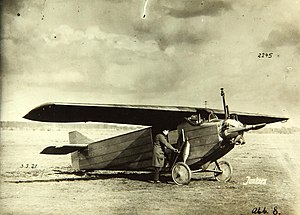Junkers K 16
| Junkers K 16 | |
|---|---|

|
|
| Type: | Touring plane |
| Design country: | |
| Manufacturer: | |
| First flight: |
March 3, 1921 |
| Production time: |
1921-1925 |
| Number of pieces: |
17th |
The Junkers K 16 was a business jet made by the German manufacturer Junkers & Co. in the early 1920s. In addition to the pilot, the high- wing aircraft could accommodate two more people. K stands for "cabin aircraft". In-house it was also referred to as the J 16.
history
The K 16 was created in 1921 based on knowledge gained with the Junkers J 15 . It was developed by Junkers chief engineer Otto Reuter . The first flight took place on March 3, 1921. After the victorious powers of the First World War issued a total aircraft construction ban on May 11 of that year, the machine was then dismantled into its individual parts in order to avoid confiscation and brought to the Netherlands. There the further flight took place. In 1923 it was first exhibited in public at the Gothenburg Air Exhibition.
The aircraft was mainly used on sightseeing flights or as a company aircraft, but it was also used as a sports machine .
construction
Designed as a cantilever high-wing aircraft, it largely took over the design of its predecessor J 15. However, the open cockpit was relocated in front of the passenger cabin in order to give the pilot a better view and to protect him from the turbulence of the engine's exhaust gas. The fuselage of the machine had only a small ground clearance, so that one could step into the cabin. The wingspan, which was 11 meters in the prototype, was increased to 12.80 meters in the series version.
The machine was initially equipped with a 45 kW radial engine Sh 4 from Siemens & Halske and thus complied with the regulations of the post-war construction restrictions imposed by the Versailles Treaty . With a cruising speed of around 125 km / h, however, the aircraft was comparatively slow. After the presentation in Gothenburg in 1923, the Siemens & Halske Sh 5 with 63 kW (K 16a) and later the Bristol Lucifer with 74 kW (K 16ce) were installed, which enabled a speed gain of 10 km / h to be achieved. A machine exported to Czechoslovakia with the registration number L-BACA (K 16bo) received a 96 kW Walter motor , the speed increased to 150 km / h. The K 16bi variant from 1925 was equipped with a 92 kW Siemens Sh 12 .
Technical specifications
| Parameter | Data (prototype, 1921) | Data (K 16ba, 1925) |
|---|---|---|
| crew | 1 | |
| Passengers | 2 | |
| length | 8.00 m | |
| span | 11.00 m | 12.80 m |
| height | 2.75 m | |
| Wing area | 16.50 m² | 19.00 m² |
| Wing extension | 7.33 | 8.60 |
| Empty mass | 430 | 535 kg |
| Payload | 282 kg | 315 kg |
| Takeoff mass | 712 kg | 850 kg |
| Wing loading | 43.15 kg / m² | 44.73 kg / m² |
| Power load | 15.47 kg / kW (11.48 kg / hp) | 13.70 kg / kW (10.00 kg / PS) |
| Area performance | 2.79 kW / m² (3.76 PS / m²) | 3.26 kW / m² (4.47 PS / m²) |
| Engine | an air-cooled five-cylinder - radial engine | an air-cooled seven-cylinder star engine |
| Type | Siemens & Halske Sh 4 | Siemens & Halske Sh 5 |
| power | Starting power 62 HP (46 kW) Nominal power 58 HP (43 kW) on the ground Continuous power 50 HP (37 kW) |
Starting power 85 HP (63 kW), nominal power 80 HP (59 kW) on the ground, continuous power 76 HP (56 kW) on the ground |
| Top speed | 145 km / h near the ground | 170 km / h near the ground |
| Cruising speed | 120 km / h near the ground | 140 km / h near the ground |
| Landing speed | 90 km / h | |
| Service ceiling | 3000 m | 2500 m |
| Range | maximum 600 km | |
| Flight time | maximum 5 h | |
See also
literature
- Günter Schmitt: Junkers and his planes . 2nd unchanged edition. Transpress, Berlin 1986, ISBN 3-344-00192-2 , p. 91/92 .
- Wolfgang Wagner: German air traffic - the pioneering years 1919–1925 . Bernard & Graefe, Koblenz 1987, ISBN 3-7637-5274-9 , pp. 217 ff .
Web links
- Junkers K 16 on Junkers.de. Retrieved April 13, 2017 .



